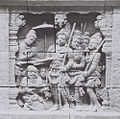The Jataka tales are a voluminous body of literature concerning the stories of previous births of Gautama Buddha. Following is the list of Jataka tales mentioned in Buddhist literature or mythology. The tales are dated between 300 BC and 400 AD.
Contents
- In Pali Canon
- In Arya Śura's Jatakamala
- Pannasa Jataka
- In Mahavastu
- Haribhatta's Jatakamala
- Gallery
- See also
- References
























